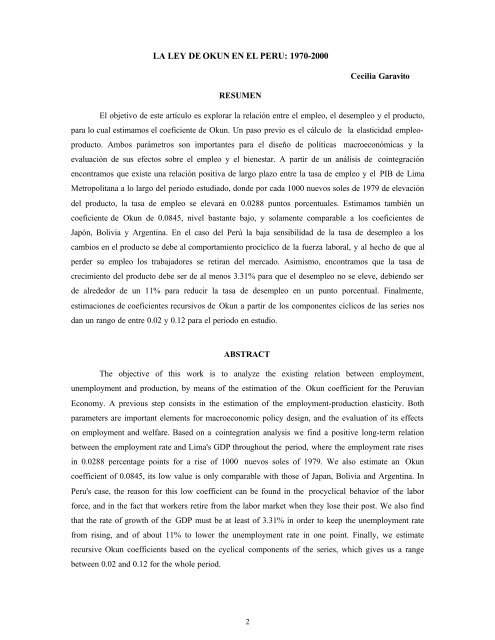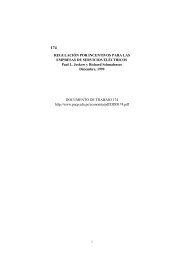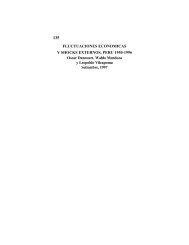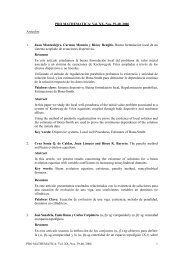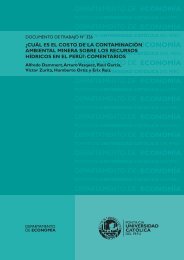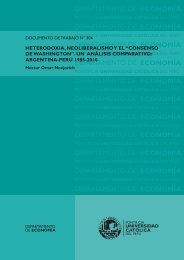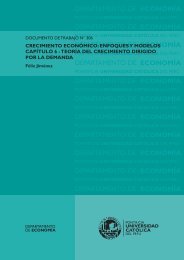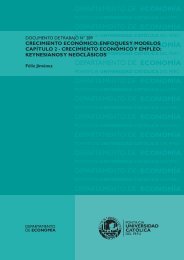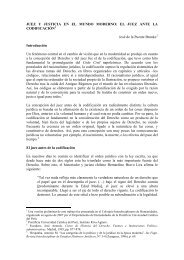La ley de Okun en el Perú - Pontificia universidad católica del ...
La ley de Okun en el Perú - Pontificia universidad católica del ...
La ley de Okun en el Perú - Pontificia universidad católica del ...
Create successful ePaper yourself
Turn your PDF publications into a flip-book with our unique Google optimized e-Paper software.
LA LEY DE OKUN EN EL PERU: 1970-2000Cecilia GaravitoRESUMENEl objetivo <strong>de</strong> este artículo es explorar la r<strong>el</strong>ación <strong>en</strong>tre <strong>el</strong> empleo, <strong>el</strong> <strong>de</strong>sempleo y <strong>el</strong> producto,para lo cual estimamos <strong>el</strong> coefici<strong>en</strong>te <strong>de</strong> <strong>Okun</strong>. Un paso previo es <strong>el</strong> cálculo <strong>de</strong> la <strong>el</strong>asticidad empleoproducto.Ambos parámetros son importantes para <strong>el</strong> diseño <strong>de</strong> políticas macroeconómicas y laevaluación <strong>de</strong> sus efectos sobre <strong>el</strong> empleo y <strong>el</strong> bi<strong>en</strong>estar. A partir <strong>de</strong> un análisis <strong>de</strong> cointegración<strong>en</strong>contramos que existe una r<strong>el</strong>ación positiva <strong>de</strong> largo plazo <strong>en</strong>tre la tasa <strong>de</strong> empleo y <strong>el</strong> PIB <strong>de</strong> LimaMetropolitana a lo largo <strong>de</strong>l periodo estudiado, don<strong>de</strong> por cada 1000 nuevos soles <strong>de</strong> 1979 <strong>de</strong> <strong>el</strong>evación<strong>de</strong>l producto, la tasa <strong>de</strong> empleo se <strong>el</strong>evará <strong>en</strong> 0.0288 puntos porc<strong>en</strong>tuales. Estimamos también uncoefici<strong>en</strong>te <strong>de</strong> <strong>Okun</strong> <strong>de</strong> 0.0845, niv<strong>el</strong> bastante bajo, y solam<strong>en</strong>te comparable a los coefici<strong>en</strong>tes <strong>de</strong>Japón, Bolivia y Arg<strong>en</strong>tina. En <strong>el</strong> caso <strong>de</strong>l Perú la baja s<strong>en</strong>sibilidad <strong>de</strong> la tasa <strong>de</strong> <strong>de</strong>sempleo a loscambios <strong>en</strong> <strong>el</strong> producto se <strong>de</strong>be al comportami<strong>en</strong>to procíclico <strong>de</strong> la fuerza laboral, y al hecho <strong>de</strong> que alper<strong>de</strong>r su empleo los trabajadores se retiran <strong>de</strong>l mercado. Asimismo, <strong>en</strong>contramos que la tasa <strong>de</strong>crecimi<strong>en</strong>to <strong>de</strong>l producto <strong>de</strong>be ser <strong>de</strong> al m<strong>en</strong>os 3.31% para que <strong>el</strong> <strong>de</strong>sempleo no se <strong>el</strong>eve, <strong>de</strong>bi<strong>en</strong>do ser<strong>de</strong> alre<strong>de</strong>dor <strong>de</strong> un 11% para reducir la tasa <strong>de</strong> <strong>de</strong>sempleo <strong>en</strong> un punto porc<strong>en</strong>tual. Finalm<strong>en</strong>te,estimaciones <strong>de</strong> coefici<strong>en</strong>tes recursivos <strong>de</strong> <strong>Okun</strong> a partir <strong>de</strong> los compon<strong>en</strong>tes cíclicos <strong>de</strong> las series nosdan un rango <strong>de</strong> <strong>en</strong>tre 0.02 y 0.12 para <strong>el</strong> periodo <strong>en</strong> estudio.ABSTRACTThe objective of this work is to analyze the existing r<strong>el</strong>ation betwe<strong>en</strong> employm<strong>en</strong>t,unemploym<strong>en</strong>t and production, by means of the estimation of the <strong>Okun</strong> coeffici<strong>en</strong>t for the PeruvianEconomy. A previous step consists in the estimation of the employm<strong>en</strong>t-production <strong>el</strong>asticity. Bothparameters are important <strong>el</strong>em<strong>en</strong>ts for macroeconomic policy <strong>de</strong>sign, and the evaluation of its effectson employm<strong>en</strong>t and w<strong>el</strong>fare. Based on a cointegration analysis we find a positive long-term r<strong>el</strong>ationbetwe<strong>en</strong> the employm<strong>en</strong>t rate and Lima's GDP throughout the period, where the employm<strong>en</strong>t rate risesin 0.0288 perc<strong>en</strong>tage points for a rise of 1000 nuevos soles of 1979. We also estimate an <strong>Okun</strong>coeffici<strong>en</strong>t of 0.0845, its low value is only comparable with those of Japan, Bolivia and Arg<strong>en</strong>tina. InPeru's case, the reason for this low coeffici<strong>en</strong>t can be found in the procyclical behavior of the laborforce, and in the fact that workers retire from the labor market wh<strong>en</strong> they lose their post. We also findthat the rate of growth of the GDP must be at least of 3.31% in or<strong>de</strong>r to keep the unemploym<strong>en</strong>t ratefrom rising, and of about 11% to lower the unemploym<strong>en</strong>t rate in one point. Finally, we estimaterecursive <strong>Okun</strong> coeffici<strong>en</strong>ts based on the cyclical compon<strong>en</strong>ts of the series, which gives us a rangebetwe<strong>en</strong> 0.02 and 0.12 for the whole period.2


